Standard Installation Guide
You complete the Sertifi installation for Salesforce Classic in six steps.
Downloading and installing the Sertifi app for Salesforce Lightning
To download and install the app to your Salesforce account:
Click the lightning gear icon
 from your Salesforce Lightning account
from your Salesforce Lightning accountClick Setup from the dropdown menu.
Navigate to Platform Tools > Apps > AppExchange Marketplace from the left-hand navigation.
Enter Sertifi in the quick find bar.
Press Enter.
Click the Sertifi Electronic Signatures icon from the search results.
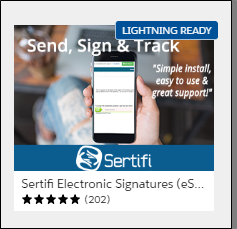
Click Get It Now at the bottom of the Sertifi for Salesforce app screen in the app exchange.
If prompted, log into the AppExchange.
Click Allow in the AppExchange login popup.
Click Install in This Org or Install in a Sandbox Org depending on where you want to install the Sertifi app.
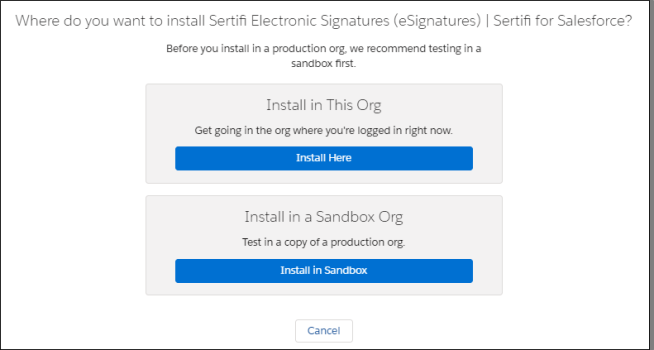
Select that you agree to Terms & Conditions in the Confirm Installation Details popup.
Click Confirm and Install.
Click Install for All Users, and then click Install.
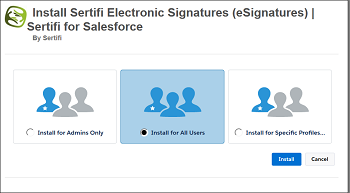
Select Yes, grant access to these third-party web sites, and then click Continue.
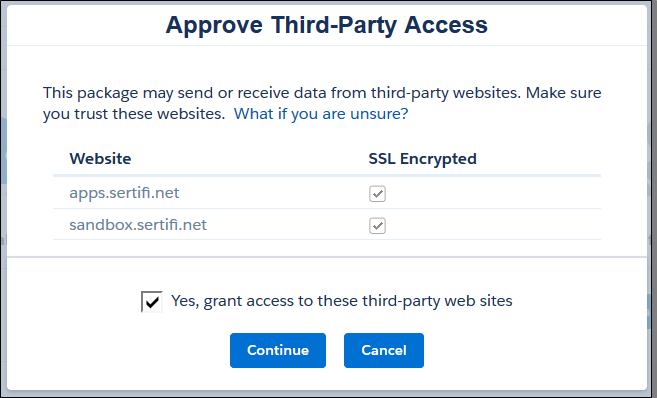
If your installation takes a long time, you’ll receive an email when installation is complete. Sertifi appears in your Installed Packages section of Salesforce.
Creating your backend portal
To create your backend portal:
Enter Installed Packages in the Quick Find search bar from your Salesforce account.
Click Installed Packages in the results.
Click Configure next to Sertifi ESign for Salesforce.com. A popup opens.
Enter the following details in the Account Information section:
Account Title – enter your company name.
Account URL – enter your company name without spaces. This will create your custom portal URL. You'll use this URL to access your backend Sertifi portal.
Optional - Click Choose File to browse your machine and upload your company’s logo. The logo appears on your portal and is visible in your file sends, so all of your messaging is branded appropriately. You can also send your logo to your Customer Success Manager to update it at any time.
Enter your Salesforce username and password in the Salesforce PUSH Details section.
Optional – Click Sandbox if you’re installing the app in a sandbox environment.
Click Save.
Copy and paste your API code in a separate window. You'll need to use this code later in the setup process.
Your Sertifi Backend portal is now set up. Contact your Sertifi CSM to provide you Super Admin user access.
Customizing your settings
It’s important to customize your settings for the app to tailor it to the workflow you want to establish in your Salesforce organization. For example, you can choose where you want to store your completed documents.
Sertifi enables certain key custom settings out-of-the-box with the Salesforce app. If you want to further customize these settings, speak with your Customer Success Manager for more details.
To add custom settings:
Enter Custom Settings in the Quick Find search bar from your Salesforce account.
Click Custom Settings.
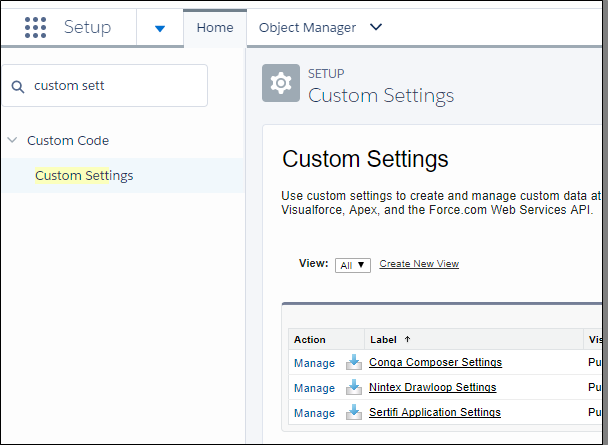
Click Manage next to Sertifi Application Settings.
Click New to create a new custom setting for the Sertifi app.
Refer to the Custom Settings guide for information on how to define your Custom Settings for the Sertifi app.
Click Save.
Adding the Sertifi button to your Page Layout
After you configure your custom settings for your Sertifi app, you must add the newly created Sertifi E-Sign button to the Page Layout of the object for which you configured Sertifi. If you don't add this button to your page layout, no one can use Sertifi to send documents.
Note
If you set up Sertifi on a custom object, the Sertifi Related List will already be present on the page layout.
To add the Sertifi Button:
Select the Object Manager Tab next to the Home tab in your Salesforce portal.
Click the name of the object you setup Sertifi on. For example, Opportunity.
Click Page Layouts in the left-hand navigation bar.
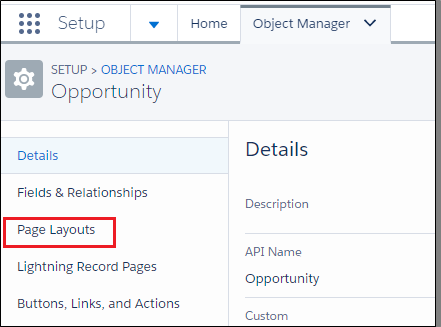
Click Opportunity Layout.
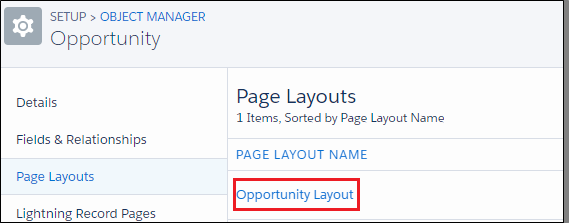
Click Mobile & Lightning Actions in left-hand list in the Opportunity Layout builder.
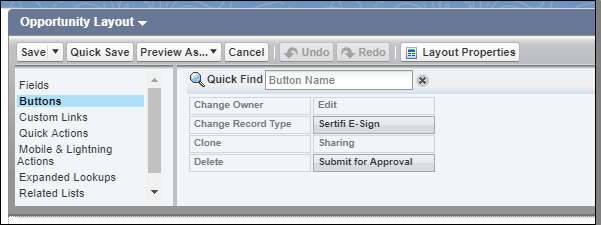
Click and drag the Sertifi E-Sign button under the Salesforce Mobile & Lightning Experience Actions header.
Optional – You can also add the Sertifi button to your Salesforce Classic layout. To do this:
Select Buttons from the object layout card.
Click and drag the Sertifi E-Sign button where you want the button to appear.
Navigate back to the top of the page, and then select Related Lists in the object layout card.
Click and drag the Sertifi EContracts list where you want the list to appear.
Click

Add or remove Selected Fields using the Add and Remove arrows. These fields will appear in your related list on the object layout.
Select Created Date from the dropdown menu, and then click Descending.
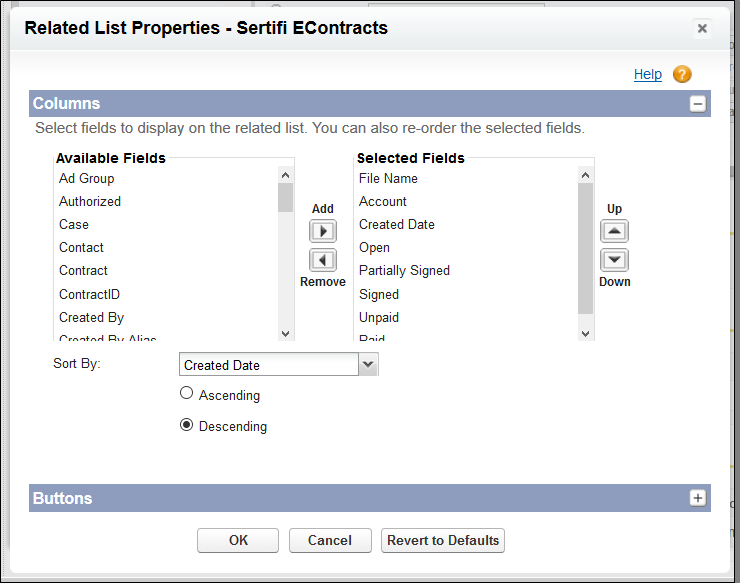
Click the + (plus sign) for the Buttons section.
Deselect New and Change Owner.
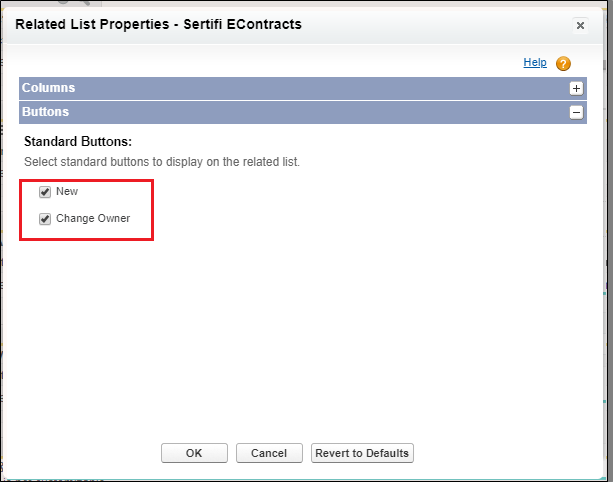
Click Ok.
Click Save to save your page layout.
Click Yes in the Overwrite Users' Related List Customizations? popup.
Note
Sertifi recommends customizing your layout so you see your most recent activity first.
To do this:
Navigate to Setup > Create > Objects.
Search for Sertifi EContract in the list of Objects.
Scroll down to Page Layouts.
Click Edit next to the Sertifi Layout.
Scroll down to the EContract Activities related list.
Click the wrench icon.

Select Activity Timefrom the Sort By dropdown menu.
Click Descending.
Click + (plus sign) to expand the Buttons section.
Deselect New and Change Owner.
Click Ok.
Click Save.
Enabling Real Time Updates in Salesforce Classic
This is the final step in completing your Salesforce installation, and it requires Corporate Admin access to the Sertifi portal. If necessary, contact your Customer Success Manager to identify the Corporate Admin at your organization, or contact Sertifi Support.
We recommend enabling real time updates so your file sends are automatically pushed to your Sertifi portal for storage.
To enable real time updates:
Login to your Sertifi Portal using the URL you created when setting up your app in Salesforce.
Navigate to Administration > Account Settings > Real Time Updates.
Change the update type to Salesforce OAuth2.
Enter an email address in the Failure Notification Email field. If you have an integration user account, please use this account’s email.
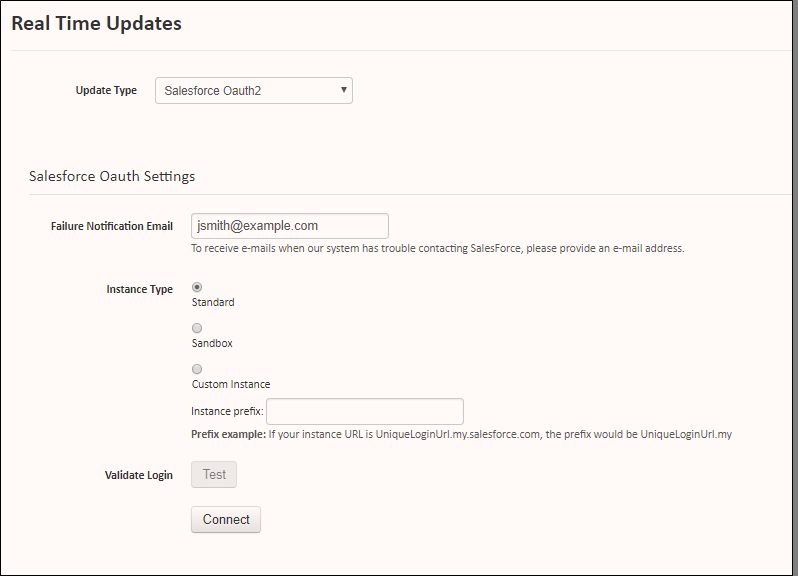
Select the Instance type, and then click Connect. A new tab opens.
Enter your Salesforce credentials. If you have an integration user account, please use this account’s credentials.
Click Allow.
You’ve successfully installed and set up your Sertifi app. You’re taken back to your Sertifi Portal and now see a green bar stating Connected.